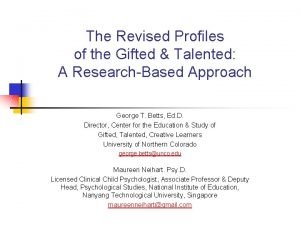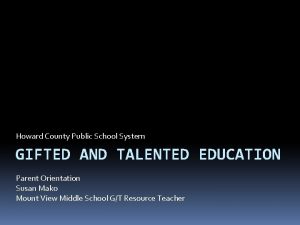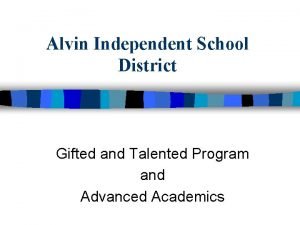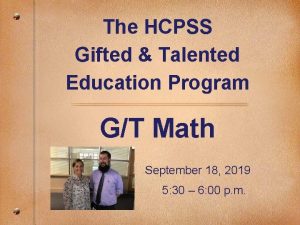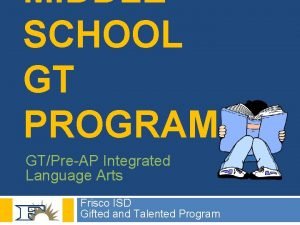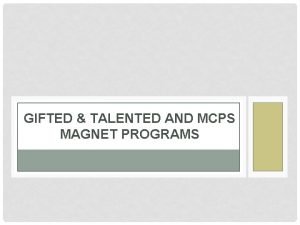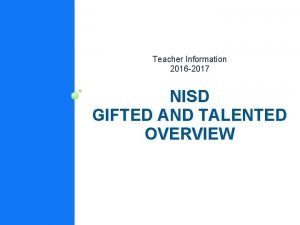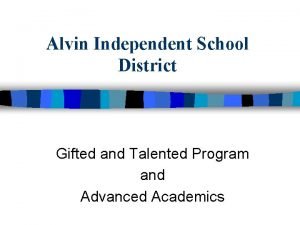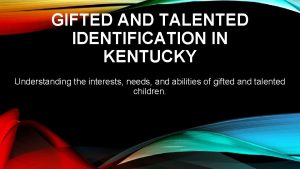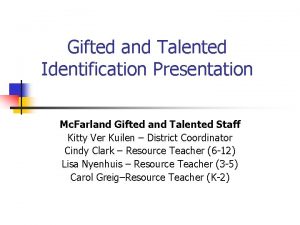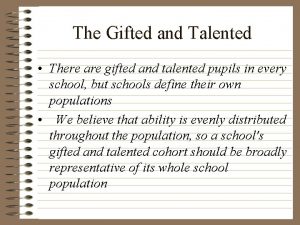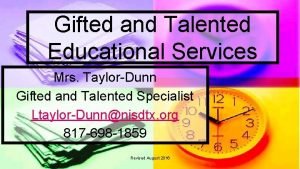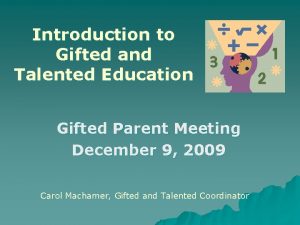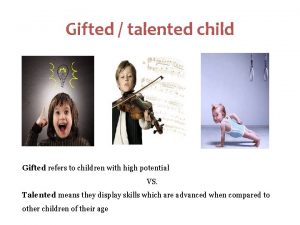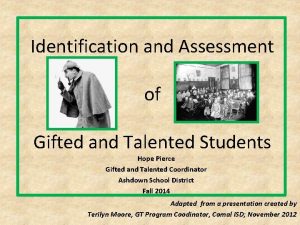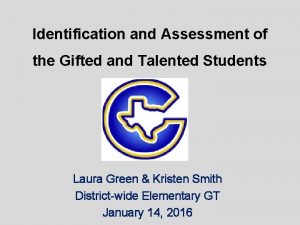GIFTED AND TALENTED IDENTIFICATION IN KENTUCKY Understanding the










- Slides: 10

GIFTED AND TALENTED IDENTIFICATION IN KENTUCKY Understanding the interests, needs, and abilities of gifted and talented children.

WHAT DOES KENTUCKY LAW SAY ABOUT GIFTED AND TALENTED CHILDREN? • Gifted and talented children and their rights are protected under a number of statutory and regulatory requirements. • 704 KAR 3: 285 - Programs for the gifted and talented • Requirements for identification, Primary Talent Pool, services, fiscal responsibilities, and annual development of a Gifted Student Service Plan (GSSP), twice annual progress reports. • KRS 157. 224 - Statewide plan for exceptional education programs. • Gifted students are recognized as a group of exceptional students with rights to an education that meets their individual needs. • Gifted students differ in one or more respects from same-age peers in physical, mental, learning, emotional, of social characteristics and abilities to such a degree that they need special educational programs or services fro them to benefit from the regular or usual facilities or educational programs of the public schools in the districts which they reside. • KRS 156. 730 - Interstate compact on Educational Opportunity for Military Children. • Gifted and talented military student identifications SHALL be honored by receiving schools.

WHAT GRADE LEVEL STIPULATIONS ARE INCLUDED IN REGULATION? • Grades K-3 - Primary Talent Pool • Talent Pool as defined by 704 KAR 3: 285 - “Talent pool” means a group of primary students informally selected as having characteristics and behaviors of a high potential learner and further diagnosed using a series of informal and formal measures to determine differentiated service delivery needs during their stay in the primary program. • High Potential Learner as defined by 703 KAR 3: 285 - “High potential learners” means those students who typically represent the top quartile (twenty-five (25) percent) of the entire student population in terms of the degree of demonstrated gifted characteristics and behaviors and require differentiated service experiences to further develop their interests and abilities.

WHAT GRADE LEVEL STIPULATIONS ARE INCLUDED IN REGULATION? • Grades 4 -12 • Formal Identification in one (or more) of the following areas: • • Leadership Creativity General Intellectual Specific Academic Aptitude • • Language Arts Math Science Social Studies • Visual and Performing Arts • • Art Music Dance Drama

WHAT GRADE LEVEL STIPULATIONS ARE INCLUDED IN REGULATION? • Grades 4 -12 • Students in grades 4 -12 that have been formally identified are required to receive annual services that are outlined in the Gifted Student Service Plan. • Multiple service options must be provided. • Formal Identification requirements for each area are outlined in 704 KAR 3: 285 and is outlined in district level procedures. • See your gifted and talented contact for any questions.

TALENT POOL IDENTIFICATION BASED ON 704 KAR 3: 285 • Identification and Diagnosis of Gifted Characteristics, Behaviors, and Talent and Determination of Eligibility for Services. (1) A district shall adopt policies and procedures which shall provide for identification and diagnosis of strengths, gifted behaviors and talents through: • (a) Informal selection and diagnosis in the primary program; • (7) In the primary program, formal, normed measures may be used for diagnosing the level of instructional service needed by a student and for evaluation of student progress. Data from formal, normed measures shall not be used for the purpose of eliminating eligibility for services to a child in the primary program but may be used to discover and include eligible students overlooked by informal assessment.

TRAITS OF YOUNG GIFTED CHILDREN • • • As infants, may get fussy if facing one direction for too long As infants, appear alert Need less sleep, even as infants Frequently reach 'milestones' such as walking and first speech earlier than average May speak late, but then speak in complete sentences Strong desire to explore, investigate, and master the environment (opens up cabinets, takes things apart) • Toys and games mastered early, then discarded • Very active (but activity with a purpose, not to be confused with ADHD) • Can distinguish between reality and fantasy (questions about Santa or the tooth fairy come very early!)

TRAITS OF GIFTED CHILDREN • May read early • May exhibit intense interest in a particular subject area. • May struggle to stay on task. • May read voraciously. • May struggle with perfectionism. • May act out in class. • May talk constantly. • May sound more adult in conversation than other students. • May complete work quickly and correctly.

WHAT TO DO? • • Schedule a time to meet with your gifted and talented contact. Take some notes about behaviors the child is exhibiting. Collect some work samples from the student. If you have received any communications or had interactions with the parent, talk with your GT contact regarding the student. • Work with the gifted and talented teacher to determine if the student qualifies for gifted services. • Determine classroom intervention strategies to work with the student until a plan is developed. • Remember that the student may not be advanced in all areas of his academic, social, or emotional development. • Just because the child can read doesn’t mean he/she is physically, emotionally, or socially above his/her peers.

THIS STUDENT IS IDENTIFIED FOR TALENT POOL OR GT- NOW WHAT? • Work with the Gifted and Talented contact to determine classroom based services. • Use preassessment and differentiation to design activities that are challenging to the child. • Work with parents to determine any enrichment activities that may be beneficial to the student outside of the regular classroom day. • Be open minded about possible options for acceleration, differentiation, flexible grouping. • Keep and open line of communication between the classroom and the GT teacher for assistance, resources, and guidance in best servicing the needs of each student.
 Betts neihart profiles of the gifted and talented
Betts neihart profiles of the gifted and talented The gifted philippines
The gifted philippines Howard county gifted and talented
Howard county gifted and talented Alvin isd gifted and talented
Alvin isd gifted and talented Hcpss gifted and talented
Hcpss gifted and talented Frisco isd gt testing
Frisco isd gt testing Howard county gifted and talented
Howard county gifted and talented Mcps-parentinput
Mcps-parentinput The anderson school gifted and talented nyc
The anderson school gifted and talented nyc Nisd gifted and talented program
Nisd gifted and talented program Alvin isd gifted and talented
Alvin isd gifted and talented
